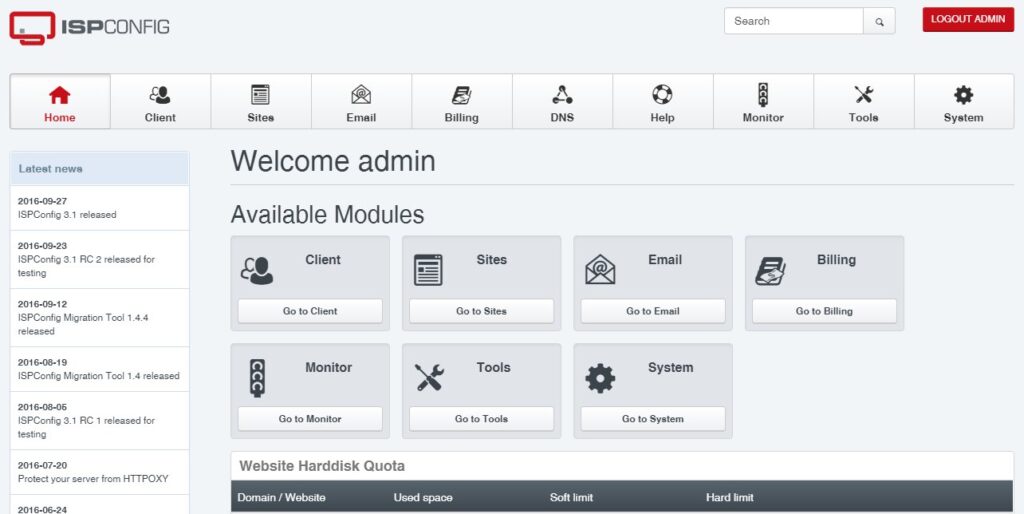ISPConfig ist ein hervoragendes Admin Control Panel (ACP) für die automatisierte Kundenverwaltung und Steurung deines Servers. ACP´s wie ISPConfig spielen ihre erheblichen Vorteile darin aus, dass bei der Neuanlage eines Kunden virtuelle Hosts mit einem minimalen Zeitaufwand eingerichtet werden können. Es beherrscht daher hervoragend das zusammenspiel der einzelnen Serverkomponenten die ich in meinem vorhergehenden Tutorial Apache Webserver auf Debian10 beschrieben habe.
In diesem Tutorial zeige ich dir nun, wie ISPConfig auf einem Debian10 System mit dem Apache Webserver installiert wird. Wir können es wie folgt deaktivieren:
AppAmor deaktivieren
AppArmor ist eine Sicherheitserweiterung (ähnlich SELinux), die erweiterte Sicherheit bieten soll. Meiner Meinung nach braucht man es nicht, um ein sicheres System zu konfigurieren. Dies war das Ergebnis einer wochenlangen Fehlersuche, weil Serverdienste nicht ordnungsgemäß gestartet werden konnten. Daher deaktiviere ich es (dies ist ein Muss, wenn Sie ISPConfig später installieren möchten).
Wir können es wie folgt deaktivieren:
# service apparmor stop
# update-rc.d -f apparmor remove
# apt-get remove apparmor apparmor-utils1 Herunterladen von ISPConfig 3.2
So installierst du ISPConfig 3 aus der zuletzt veröffentlichten Version:
# cd /tmp
# wget http://www.ispconfig.org/downloads/ISPConfig-3-stable.tar.gz
# tar xfz ISPConfig-3-stable.tar.gz
# cd ispconfig3_install/install/2 ISPConfig installieren
Im nächsten Schritt führen wir das Installationsprogramm von ISPConfig aus.
# php -q install.phpDadurch wird das ISPConfig-3-Installationsprogramm gestartet. Das Installationsprogramm wird alle Dienste wie Postfix, Dovecot, etc. für Sie konfigurieren. Ein manuelles Setup, wie es für ISPConfig 2 erforderlich ist, ist nicht mehr notwendig.
# php -q install.php--------------------------------------------------------------------------------
_____ ___________ _____ __ _ ____
|_ _/ ___| ___ \ / __ \ / _(_) /__ \
| | \ `--.| |_/ / | / \/ ___ _ __ | |_ _ __ _ _/ /
| | `--. \ __/ | | / _ \| '_ \| _| |/ _` | |_ |
_| |_/\__/ / | | \__/\ (_) | | | | | | | (_| | ___\ \
\___/\____/\_| \____/\___/|_| |_|_| |_|\__, | \____/
__/ |
|___/
-------------------------------------------------------------------------------->> Initial configurationOperating System: Debian 10.0 (Buster) or compatibleFollowing will be a few questions for primary configuration so be careful.
Default values are in [brackets] and can be accepted with <ENTER>.
Tap in "quit" (without the quotes) to stop the installer.Select language (en,de) [en]: <-- Hit EnterInstallation mode (standard,expert) [standard]: <-- Hit EnterFull qualified hostname (FQDN) of the server, eg server01.exemple.de [server01.example.de]: <-- Hit EnterMySQL server hostname [localhost]: <-- Hit EnterMySQL server port [3306]: <-- Hit EnterMySQL root username [root]: <-- Hit EnterMySQL root password []: <-- Enter your MySQL root passwordMySQL database to create [dbispconfig]: <-- Hit EnterMySQL charset [utf8]: <-- Hit EnterConfiguring Postgrey
Configuring Postfix
Generating a 4096 bit RSA private key
.......................................................................++
........................................................................................................................................++
writing new private key to 'smtpd.key'
-----
You are about to be asked to enter information that will be incorporated
into your certificate request.
What you are about to enter is what is called a Distinguished Name or a DN.
There are quite a few fields but you can leave some blank
For some fields there will be a default value,
If you enter '.', the field will be left blank.
-----
Country Name (2 letter code) [AU]: <-- Enter 2 letter country code
State or Province Name (full name) [Some-State]: <-- Enter the name of the state
Locality Name (eg, city) []: <-- Enter your city
Organization Name (eg, company) [Internet Widgits Pty Ltd]: <-- Enter company name or press enter
Organizational Unit Name (eg, section) []: <-- Hit Enter
Common Name (e.g. server FQDN or YOUR name) []: <-- Enter the server hostname, in my case: server1.example.de
Email Address []: <-- Hit Enter
Configuring Mailman
Configuring Dovecot
Configuring Spamassassin
Configuring Amavisd
Configuring Getmail
Configuring BIND
Configuring Jailkit
Configuring Pureftpd
Configuring Apache
Configuring vlogger
[INFO] service Metronome XMPP Server not detected
Configuring Ubuntu Firewall
Configuring Fail2ban
[INFO] service OpenVZ not detected
Configuring Apps vhost
Installing ISPConfig
ISPConfig Port [8080]:Admin password [admin]:Do you want a secure (SSL) connection to the ISPConfig web interface (y,n) [y]: <-- Hit EnterGenerating RSA private key, 4096 bit long modulus
.......................++
................................................................................................................................++
e is 65537 (0x10001)
You are about to be asked to enter information that will be incorporated
into your certificate request.
What you are about to enter is what is called a Distinguished Name or a DN.
There are quite a few fields but you can leave some blank
For some fields there will be a default value,
If you enter '.', the field will be left blank.
-----
Country Name (2 letter code) [AU]: <-- Enter 2 letter country code
State or Province Name (full name) [Some-State]: <-- Enter the name of the state
Locality Name (eg, city) []: <-- Enter your city
Organization Name (eg, company) [Internet Widgits Pty Ltd]: <-- Enter company name or press enter
Organizational Unit Name (eg, section) []: <-- Hit Enter
Common Name (e.g. server FQDN or YOUR name) []: <-- Enter the server hostname, in my case: server01.example.de
Email Address []: <-- Hit EnterPlease enter the following 'extra' attributes
to be sent with your certificate request
A challenge password []: <-- Hit Enter
An optional company name []: <-- Hit Enter
writing RSA keyConfiguring DBServer
Installing ISPConfig crontab
no crontab for root
no crontab for getmail
Detect IP addresses
Restarting services ...
Installation completed.Das Installationsprogramm konfiguriert automatisch alle zugrunde liegenden Dienste, so dass keine manuelle Konfiguration erforderlich ist.
Danach können Sie auf ISPConfig 3 unter http(s)://server01.example.de:8080/ oder http(s)://218.250.146.166:8080/ zugreifen (http oder https hängt davon ab, was Sie bei der Installation gewählt haben). Melden Sie sich mit dem Benutzernamen admin und dem Passwort admin an (Sie sollten das Standardpasswort nach der ersten Anmeldung ändern):

![[CITSC] IT-Security & Datenschutz](https://citsc.de/wp-content/uploads/2021/10/cropped-citsc_logo.png)